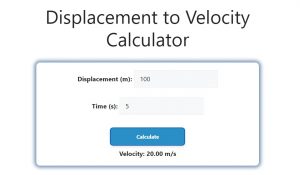About Displacement to Velocity Calculator (Formula)
The Displacement to Velocity Calculator is a valuable tool for students, engineers, and anyone interested in understanding motion. Velocity is a vector quantity that describes the rate of change of an object’s position with respect to time. By calculating velocity, you can gain insights into how quickly an object is moving in a particular direction. This calculator simplifies the process, allowing users to input displacement and time values to obtain accurate velocity measurements quickly.
Formula
The formula for calculating velocity from displacement is:
Velocity = Displacement / Time
Where:
- Displacement is the change in position of an object, measured in meters (m).
- Time is the duration of the motion, measured in seconds (s).
How to Use
Using the Displacement to Velocity Calculator is straightforward and involves the following steps:
- Measure Displacement: Determine the total displacement of the object, ensuring it is expressed in meters (m).
- Record Time: Measure the time it took for the object to travel that displacement, ensuring it is in seconds (s).
- Input Values: Enter the displacement and time values into the calculator.
- Calculate Velocity: Click the “Calculate” button to obtain the velocity.
- Review Result: Analyze the calculated velocity to understand the object’s motion.
Example
Suppose you want to calculate the velocity of a car that travels 100 meters in 5 seconds.
Using the formula:
Velocity = Displacement / Time
Velocity = 100 meters / 5 seconds
Velocity = 20 meters per second (m/s)
In this example, the car’s velocity is 20 m/s.

FAQs
- What is displacement?
- Displacement is the shortest distance from the initial to the final position of an object in a specific direction.
- What is velocity?
- Velocity is the rate at which an object changes its position, taking into account the direction of movement.
- How is velocity different from speed?
- Velocity is a vector quantity (includes direction), while speed is a scalar quantity (magnitude only).
- What units are used for displacement?
- Displacement is typically measured in meters (m).
- What units are used for time?
- Time is measured in seconds (s).
- Can displacement be negative?
- Yes, displacement can be negative if the final position is behind the starting position in a given direction.
- What if I have multiple displacements?
- For multiple displacements, sum the total displacement before entering it into the calculator.
- What if I want to calculate average velocity?
- Average velocity can be calculated using the total displacement and total time taken.
- Is the Displacement to Velocity Calculator only for linear motion?
- While primarily used for linear motion, it can also apply to any scenario where displacement and time are measured.
- Can this calculator be used for different types of objects?
- Yes, it can be used for any object, whether it’s a car, a person walking, or a projectile.
- What is instantaneous velocity?
- Instantaneous velocity refers to the velocity of an object at a specific moment in time.
- Can I use this calculator for non-uniform motion?
- Yes, but the result will represent average velocity over the measured displacement and time.
- How accurate are the results?
- The accuracy depends on the precision of your measurements for displacement and time.
- Do I need to account for direction when calculating velocity?
- Yes, direction is essential for determining velocity as it is a vector quantity.
- How can I improve my understanding of motion?
- Engaging with physics textbooks, online resources, or simulations can enhance your understanding of motion concepts.
- Is this calculator useful in real-life applications?
- Yes, it is used in various fields, including physics, engineering, and sports science.
- Can I apply this formula in 3D motion?
- Yes, in 3D motion, you can calculate displacement in three dimensions and still find velocity.
- What tools can complement the Displacement to Velocity Calculator?
- Tools like graphing calculators, motion sensors, and simulation software can provide additional insights into motion.
- Is there a limit to the values I can enter?
- Generally, no specific limits exist, but values should be realistic for physical scenarios.
- Can I use this calculator for theoretical scenarios?
- Yes, you can apply it to theoretical scenarios to explore concepts in physics.
Conclusion
The Displacement to Velocity Calculator is an essential tool for anyone looking to understand the relationship between displacement and velocity. By utilizing the formula and understanding how to input values correctly, users can obtain valuable insights into motion. This calculator is particularly useful in educational settings, research, and practical applications across various fields. With the ability to answer common questions about displacement and velocity, this tool enhances comprehension and facilitates better decision-making regarding motion analysis.